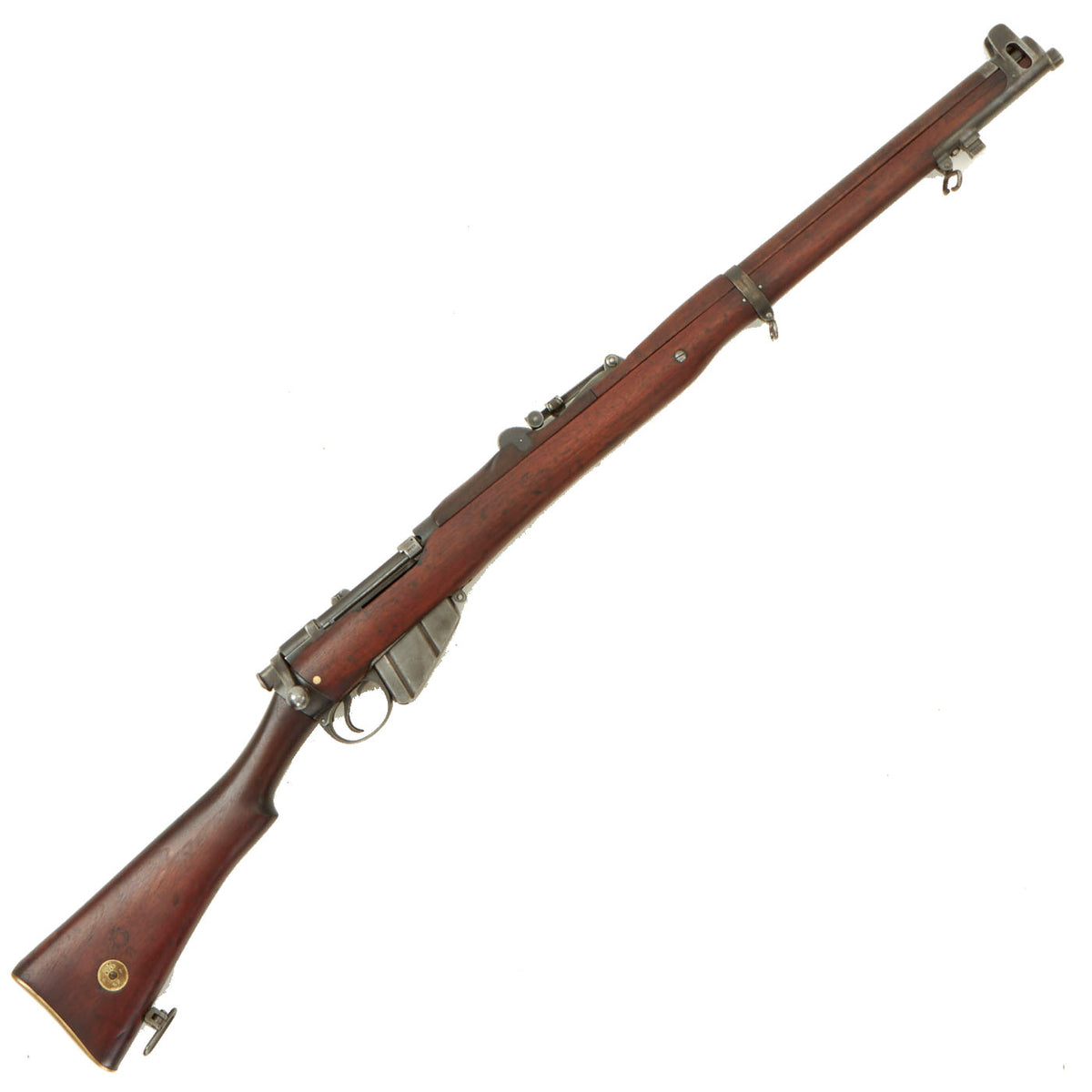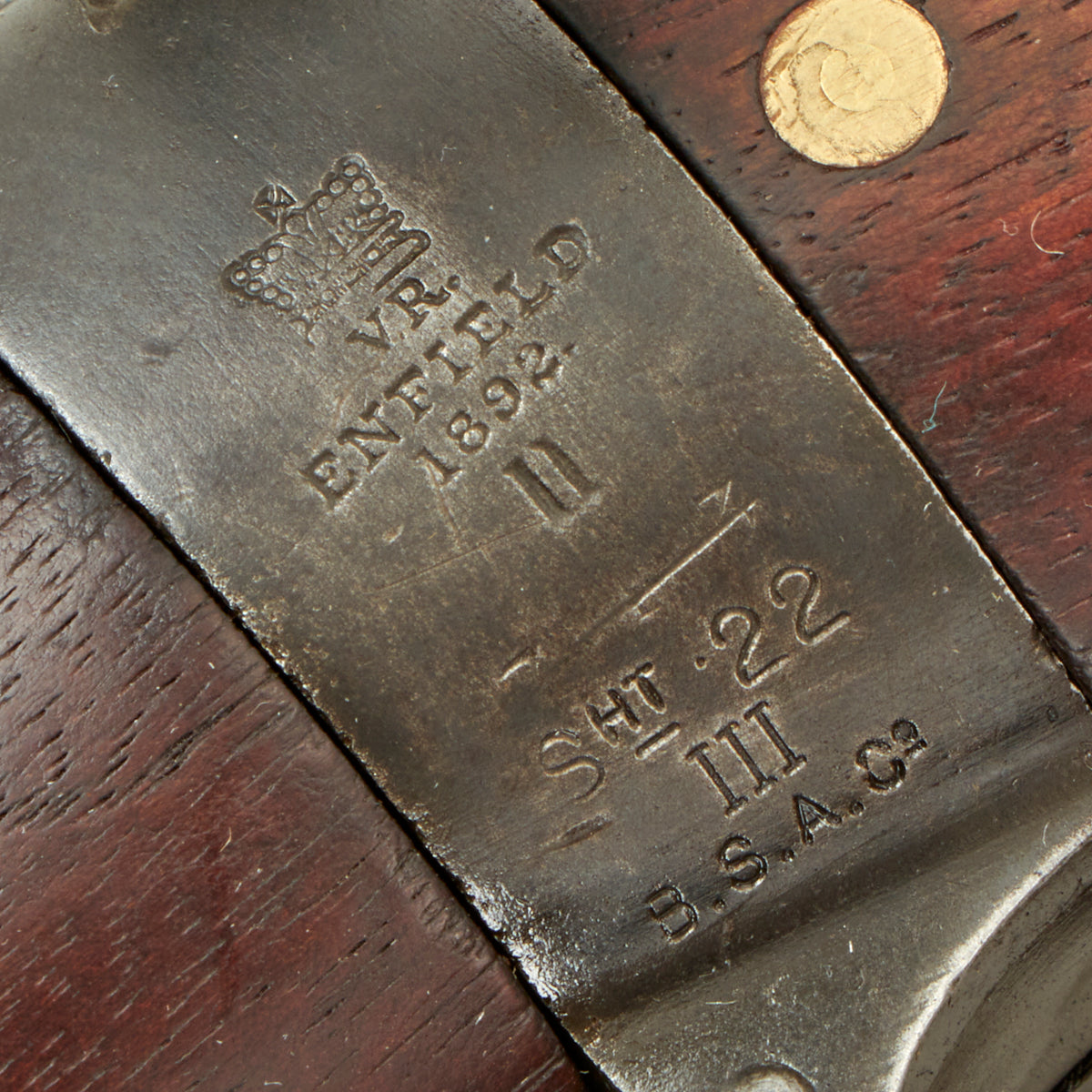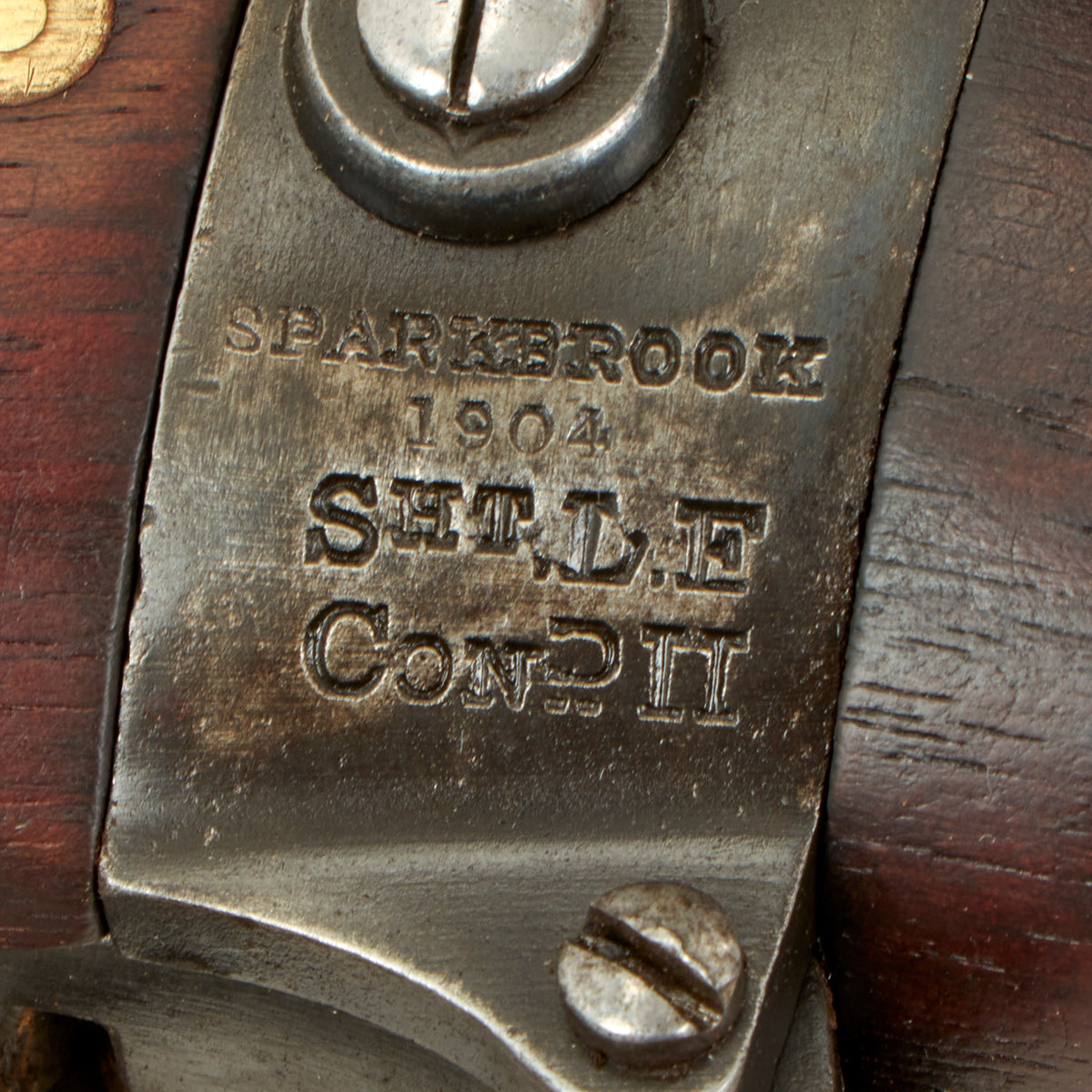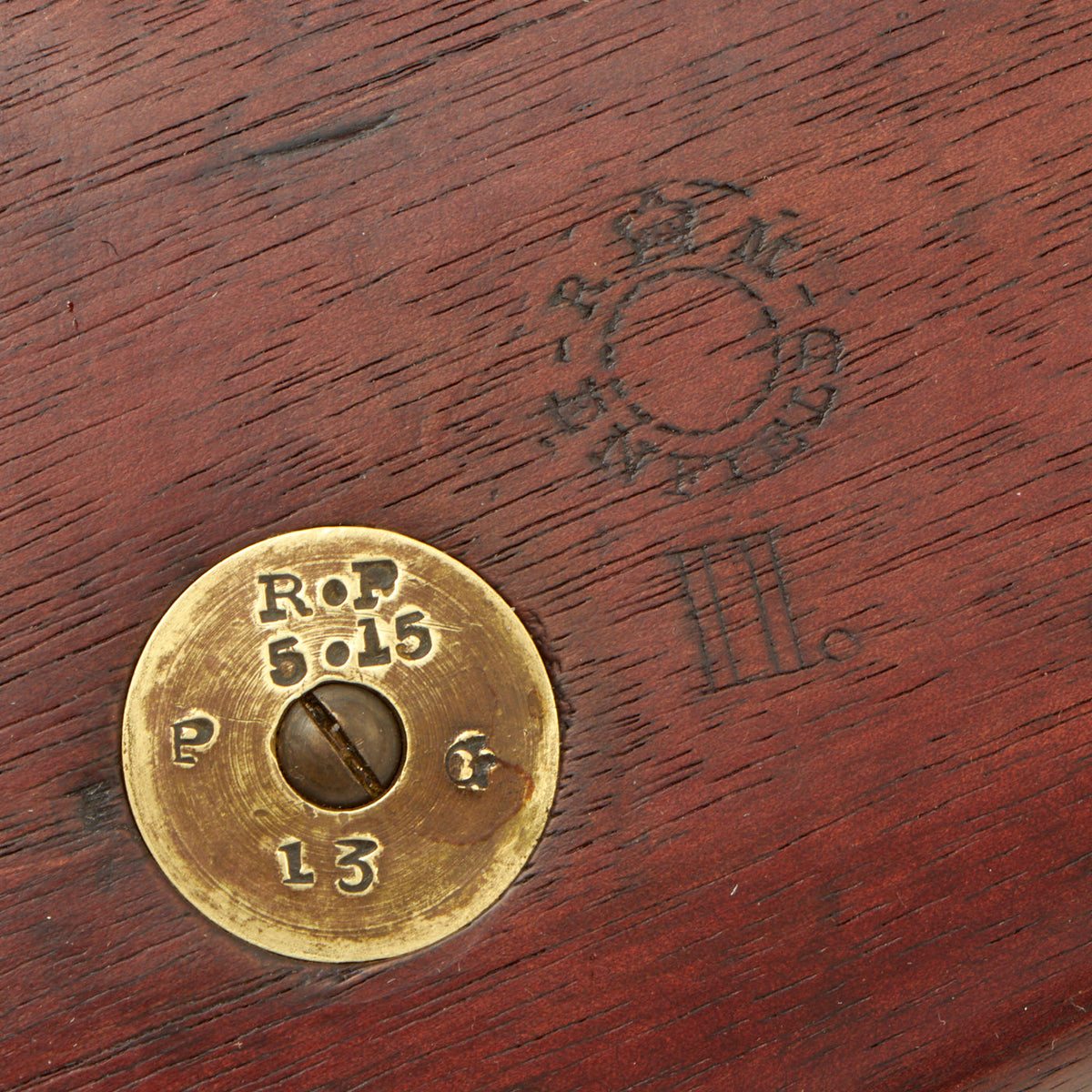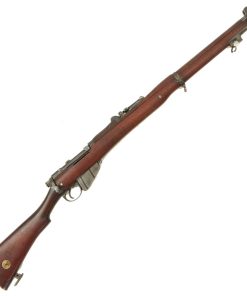Original British Lee-Metford MkII dated 1892 Converted to S.M.L.E. in 1904 and then to .22 Trainer – Serial P 14175 Original Items
$ 2.750,00 $ 687,50
Original Item: One Only. This is one rare bird! This rifle started life as an 1892 dated Lee Metford MkII .303 caliber rifle, then was converted into an extremely early S.M.L.E. configuration, and later to a .22 Training rifle.. It may well have passed through being modified to an 1895 Long Lee Enfield as well, though the markings do not indicate this. The action is also marked with serial P 14175, which is also present on the end of the nose cap. There are also the various dates of conversions, and where they were performed. These markings on this rifle help trace the history of the various refits it has gone through.
On the top right of the stock cup it is marked:
V.R.
ENFIELD
1892.
II
First, the royal cypher Crown over V.R., for Victoria Regina. Well, this Queen, longest lived of all British monarchs, had an influence far beyond the British Isles and the British Empire during the Nineteenth Century. Victorian morals dominated the cultured classes of Great Britain and the new United States, and even now, in the Twenty-First Century, nostalgic organizations such as the Victorian Riflemen thrive in the former Colonies.
ENFIELD indicates that the first incarnation of this piece was produced by the Royal Small Arms Factory at Enfield Lock and 1892 was the year of manufacture. Lastly, for its first incarnation, II tells us that it was manufactured as a “Rifle, Magazine, Lee-Metford Mark II”. In other words, this piece originated as a Lee-Metford MkII rifle. How can one measure how much history this rifle has seen? Think Second Anglo-Boer War in South Africa.
Third, the lower left of the butt socket is very clearly stamped:
SPARKBROOK
1904
SHT L.E.
CON’D II
which indicates it was modified at Royal Small Arms Factory Sparkbrook in 1904 to the “Rifle, Short, Magazine, Lee-Enfield, Converted Mark II”. Think of the very first S.M.L.E. Mk I with its exotic rear sight, rear sight protectors, and lumpy nose cap. The British, ever thrifty, began to convert long Lee-Metfords and long Lee-Enfields to S.M.L.E.s soon after sealing the pattern. All the converted rifles were called the Mark II.
Fourth and lastly, the lower right side of the butt cup is marked:
SHT. 22
III
B.S.A. Co.
This indicates that the rifles last incarnation was a “.22 Short Rifle Mk III,” and this transformation was carried out at the Birmingham Small Arms Company, which had dropped the “Metal” from the name by this time, circa 1913.
Think of British Tommies training to be the most accurate riflemen of any European army in the impending Great War, which began over 100 years ago now. Many of those remarkable riflemen were dead by the end of the year. This “little .22” is now 130 years old, and is in very, very nice condition for its age. Christian has said he hopes to be in comparable condition at that age.
Among the rarest of the rare, this rifle is the first .22 caliber trainer based on the Rifle, Short, Magazine, Lee-Enfield, or S.M.L.E. for short. Before this there were a Mk I, Mk I*, and Mk II, but all were direct conversions of Lee-Metfords or long Lee-Enfields, and did not resemble the S.M.L.E. The “Mk III” designation for this rifle is not related to the .303 caliber S.M.L.E. Mk III; it refers only to this rifle’s place in the sequence of .22 short training rifles. The model was approved on 9 August 1912, and was built on Converted Mk II and II* SMLE rifles.
The .22 Mk III rifles have some unique features. The nose cap, for instance, in side view resembles the S.M.L.E. Mk I, but on viewing it from the front it is seen that the protective sight ears do not curve in as they do on a the S.M.L.E. Mk I. The lower hand guard is of the EARLIEST S.M.L.E. Mk I design, incorporating steel wings screwed directly into the wood, but the rear sight leaf is the S.M.L.E. Mk III leaf, with windage adjustment. The butt swivel is the S.M.L.E. Mk I pattern. The front and rear volley sights are present; obviously, even though the designated ranges did not relate to the .22 caliber cartridge, they were still very useful for training in manipulation.
The magazine is present, but is empty inside, which allows the extracted cartridges to be collected The bolt head is marked “.22 No 2”. There is also a butt stock marking disc with R.F / 5.15 stamped on it. Additionally, this rifle retains the original lightened butt stock, which as three large longitudinal holes drilled under the butt plate.
The .22 Short Rifle Mk III had a short production life, from 1912 through 1914. A new .22 trainer was introduced in 1915, the “.22 RF Pattern 1914 Short Rifle No. 1”.
Specifications-
Year of Manufacture: 1892. Converted 1904 and later c. 1913
Caliber: .22 cal
Cartridge Type: Rimfire Cartridge
Overall Length: 25 Inches
Overall Length: 44 Inches
Action type: Bolt-Action
Feed System: Single Shot
Fast Shipping with Professional Packaging
Thanks to our longstanding association with UPS FedEx DHL, and other major international carriers, we are able to provide a range of shipping options. Our warehouse staff is expertly trained and will wrap your products according to our exact and precise specifications. Prior to shipping, your goods will be thoroughly examined and securely secured. We ship to thousands clients each day across multiple countries. This shows how we're dedicated to be the largest retailer on the internet. Warehouses and distribution centres can be located throughout Europe as well as the USA.
Note: Orders with more than one item will be assigned a processing date depending on the item.
Before shipping before shipping, we'll conduct a thorough inspection of the items you have ordered. Today, the majority of orders will be delivered within 48 hours. The delivery time will be between 3-7 days.
Returns
The stock is dynamic and we cannot completely manage it because multiple stakeholders are involved, including our factory and warehouse. So the actual stock may alter at any time. It's possible that you may not receive your order once the order has been made.
Our policy is valid for a period of 30 days. If you don't receive the product within 30 days, we are not able to issue a refund or an exchange.
You can only return an item if it is unused and in the same state as the day you received it. You must have the item in its original packaging.
Related products
Uncategorized
Angolan Rebel 1970s era 60mm Inert Display Mortar from Angolan Civil War Original Items
Uncategorized
Uncategorized
Uncategorized
Uncategorized
Uncategorized
Band of Brothers ORIGINAL GERMAN WWII Le. F.H. 18 10.5cm ARTILLERY PIECE Original Items
Uncategorized
Uncategorized
Uncategorized
Uncategorized
Uncategorized
Uncategorized
Uncategorized
Uncategorized
Uncategorized
Uncategorized
Uncategorized
Uncategorized
Uncategorized
Armoured Fighting Vehicles of the World: AFVs of World War One (Hardcover Book) New Made Items
